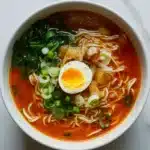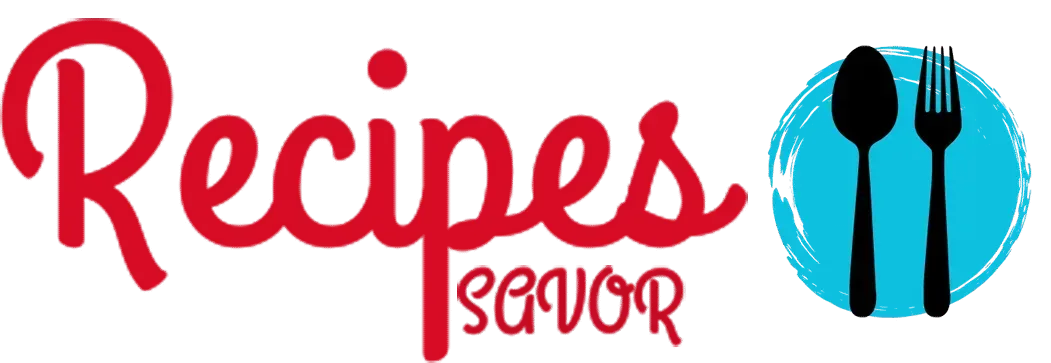Overview of Ramen
What exactly is Ramen?
Ramen is a dish that has captivated taste buds around the globe, but what elements comprise this dish, and how has it evolved? Originating from Japan, ramen consists of wheat noodles served in a rich broth flavored with various toppings. However, the dish’s roots can be traced back to China, making it a fascinating study of cultural culinary fusion. So, is ramen a noodle or a soup? This question has intrigued many food enthusiasts and is central to understanding ramen’s true essence.
Ingredients typically used in Ramen
https://recipessavor.com/ramen-noodle-soup/
Ramen’s heart lies in its simplicity and the quality of its ingredients. A standard bowl features:
- Noodles: Ramen noodles are unique for their elastic texture and slight chewiness, thanks to alkaline water called kansui.
- Broth: Ramen broth varies from clear, savory shoyu to creamy, rich tonkotsu, each with a distinct flavor.
- Toppings: Toppings like sliced meats, boiled eggs, green onions, and nori add flavor and visual appeal.
Historical Context
The journey of ramen from a simple Chinese street food to a Japanese culinary icon shows its adaptability and lasting appeal. Chinese immigrants introduced it to Yokohama in the late 19th century. Since then, ramen has evolved, with each Japanese region adding its own twist, resulting in today’s diverse variations. This historical journey helps us delve deeper into the question, is ramen a noodle or a soup?
Ramen is more than just a quick meal; it’s a canvas for culinary expression. Understanding its roots and ingredients helps us appreciate the ongoing debate over whether ramen is ramen a noodle or a soup.
Learn more about the origins and evolution of ramen in Japanese cuisine.
Understanding Ramen
What is Ramen?
Ramen, in all its glory, isn’t just a meal; it’s an experience. Each bowl is a symphony of textures and tastes, meticulously balanced to deliver comfort and satisfaction. The noodles are made from wheat flour, water, and kansui, an alkaline mineral water that gives them their signature springy texture and a slightly yellow hue. This brings us back to our central question: is ramen a noodle or a soup?
Historical Context
Tracing ramen’s lineage reveals its journey from humble beginnings to a global culinary staple. Chinese immigrants introduced ramen to Japan in the late 19th century, where it adapted to local flavors and ingredients. It quickly gained popularity among the working class as a quick, affordable, and nourishing meal. Understanding ramen’s dual identity as both noodles and soup highlights its versatility and widespread appeal. Examining its components and origins explains why many ponder, is ramen a noodle or a soup?
Ramen has played a pivotal role in Japan’s culinary scene, evolving over the decades and now celebrated worldwide with countless variations and devoted fans.
Ramen as Noodles
https://recipessavor.com/is-ramen-a-healthy-soup/
The Role of Noodles in Ramen
Ramen noodles are more than just an ingredient; they are the backbone of the dish, defining its texture and character. Made with wheat flour, water, salt, and kansui (alkaline water), the noodles have a unique firmness and elasticity that distinguish them from other types of pasta. Their ability to absorb flavors while maintaining a distinct chewiness is crucial in differentiating ramen from other noodle dishes.
The preparation of ramen noodles involves precise techniques to achieve the perfect texture. After mixing and kneading, the dough is rolled, cut, and then cooked to a specific firmness, often referred to as al dente. This process ensures that the noodles can stand up to the hot broth without becoming too soft.
Cultural Perception of Noodles in Ramen
In many cultures, particularly in Japan, the noodles are not merely a carrier for the broth but a significant component of the dish that is appreciated for its taste, texture, and quality. In ramen, the noodles are meant to be slurped, a practice that is not only socially acceptable in Japan but also encouraged, as it enhances the flavor experience and shows appreciation for the meal. This practice adds another layer to the question, is ramen a noodle or a soup?
The prominence of noodles in ramen can be observed in the various regional variations across Japan. For instance, the thin and curly noodles of Sapporo contrast with the thicker and straighter noodles found in Tokyo ramen, each style pairing with specific broths to highlight regional flavors and preferences.
By understanding the pivotal role of noodles in ramen, it becomes clear why many argue that ramen should primarily be categorized as a noodle dish. The noodles in ramen are not just an addition; they are integral to the dish’s identity and enjoyment.
As we continue to explore ramen’s identity, the emphasis on noodles helps to underscore their importance not just as a component of the dish but as a culinary art form in their own right.
Ramen as Soup
Importance of Broth in Ramen
The broth, or soup, is arguably the soul of ramen, imbuing the dish with its distinctive flavors and aromas. Crafted from a variety of bases—whether it’s pork, chicken, seafood, or vegetables—each broth type is meticulously simmered to extract deep, nuanced flavors. The complexity of ramen broth can range from the light and tangy shio (salt) broth to the rich and milky tonkotsu (pork bone) broth, each requiring hours of preparation to achieve the right flavor profile.
A good ramen broth is not just about taste but also about aroma and mouthfeel. The layers of flavor in the broth come from ingredients such as kombu (dried kelp), shiitake mushrooms, onions, garlic, and sometimes more unique items like dried sardines or bonito flakes. This broth serves as the foundation upon which the noodles and toppings are showcased, enhancing the overall eating experience.
Cultural Significance of Soup
In many culinary traditions, soup symbolizes comfort, warmth, and nourishment. Ramen broth is no exception. Often consumed for its restorative properties, especially in colder seasons or as a late-night meal, ramen offers comfort through its warm, soothing broth, reviving the spirit and senses.
In Japanese cuisine, preparing ramen broth is an art form. Chefs spend years perfecting their craft, experimenting with ingredients and techniques to create a balanced, appealing broth. This elevates ramen beyond mere sustenance to a cultural icon, revered for its depth and tradition. This craftsmanship brings us closer to answering, is ramen a noodle or a soup?
This aspect of ramen underscores why many argue it should be considered more of a soup than noodles. The broth not only carries the flavors but also embodies the tradition and culinary artistry of ramen-making. Delving into the essence of ramen, the broth’s crucial role in defining this beloved dish becomes clear, positioning ramen among the great soups of the world.
Comparative Analysis
Noodles vs. Soup: A Culinary Perspective
The debate over whether ramen is a noodle dish or a soup goes beyond semantics; it touches on the essence of what makes ramen beloved. Both noodles and broth are integral, but their importance varies depending on who you ask and where they are from.
Arguments for Ramen as Noodles
Proponents of viewing ramen primarily as a noodle dish point to the significance of the noodles’ texture and taste in the overall experience of the dish. The noodles are not just a vehicle for the broth but are appreciated for their own sake. In many Japanese ramen shops, the type of noodle and its texture can be selected, underscoring their importance. The argument here is that while the broth flavors the noodles, it is the noodles themselves that are the main focus of ramen, with their ability to convey not just taste but also the satisfaction of a hearty meal.
Arguments for Ramen as Soup
Those who argue that ramen is primarily a soup emphasize the broth’s defining role. Crafted with care and simmered for hours, the broth develops a complex flavor that cannot be easily replicated. It’s not just about seasoning the noodles but creating a rich, aromatic base that enhances all the ingredients. For many, the broth is what they crave and what provides ramen’s comforting aspect.
Insights from Chefs and Culinary Experts
Chefs and culinary experts often have varied opinions based on their training and cultural background. Some emphasize the craftsmanship of perfecting the broth, seeing it as the core of their culinary expression in ramen. Others focus on the art of noodle making, from kneading and rolling to cutting and cooking, with each step aimed at achieving the perfect bite.
In conclusion, whether ramen is viewed as primarily noodles or soup may depend on individual experiences and cultural contexts. However, it’s clear that both elements are crucial in making ramen a universally cherished dish. This balance of noodles and broth, each lending unique qualities, makes ramen not just food but an experience that resonates globally. The central debate—is ramen a noodle or a soup—remains an engaging topic for food lovers everywhere.
FAQs
Common Questions about Ramen
Given its extensive cultural heritage and current popularity, there are unavoidably a lot of inquiries on the preparation, variants, and dietary issues of ramen. Below are our responses to some of the most popular queries.
Is Ramen Considered Healthy?
The healthiness of ramen can vary significantly based on its ingredients and preparation methods. Traditional ramen, which includes fresh noodles, broth, and a variety of toppings, can offer a balanced meal. However, instant ramen is often high in sodium and preservatives, making it less healthy. Enhancing ramen with additional vegetables or opting for homemade broth can increase its nutritional value.
Can Ramen be Made Vegan or Gluten-Free?
Absolutely! For a vegan version, you can substitute the traditional meat-based broth with a rich vegetable broth and use toppings like tofu and an array of vegetables. Gluten-free ramen is achievable by selecting noodles made from rice flour or other gluten-free alternatives. Always check the labels to ensure that all ingredients meet vegan or gluten-free standards.
Best Practices for Storing and Reheating Ramen
Storing ramen effectively involves separating the noodles from the broth to prevent them from becoming soggy. Keep both components in airtight containers in the refrigerator, where they can last for up to a few days. When reheating, warm the broth separately to a boil, then add the noodles just long enough to heat through, maintaining their texture.
These FAQs not only shed light on practical aspects of enjoying ramen but also highlight its adaptability to different dietary needs and preferences, underscoring ramen’s universal appeal. Ramen is a versatile and long-lasting dish that many people adore, whether they tweak it to fit a healthy diet or modify it for various dietary restrictions.

Ramen Noodle Soup
Ingredients
For the Noodles
- 4 cups Wheat flour Essential for making ramen noodles.
- 1 cup Water Use to mix with flour.
- 1 tbsp Kansui An alkaline mineral water that gives noodles their unique texture.
For the Broth
- 8 cups Pork or chicken stock Use as a base for the broth.
- 1 tbsp Soy sauce To add flavor to broth.
- 1 tbsp Miso paste Optional, for additional flavor depth.
Toppings
- 2 pieces Soft-boiled eggs Cooked to perfection.
- 1 cup Sliced green onions For freshness.
- 1 sheet Nori (seaweed) For garnish.
- 200 grams Chashu (braised pork) Classic ramen topping.
Instructions
Prepare the Noodles
- Mix wheat flour, water, and kansui to form a dough.
- Knead for 10 minutes until smooth.
- Roll out the dough and cut it into thin strips.
- Boil in water for 3-4 minutes until al dente.
Make the Broth
- In a large pot, combine pork or chicken stock with soy sauce and miso paste.
- Simmer for at least an hour to deepen flavors.
- Strain the broth to remove solids.
Assemble the Ramen
- In bowls, place a serving of noodles.
- Pour the hot broth over the noodles.
- Top with soft-boiled eggs, green onions, nori, and chashu.












